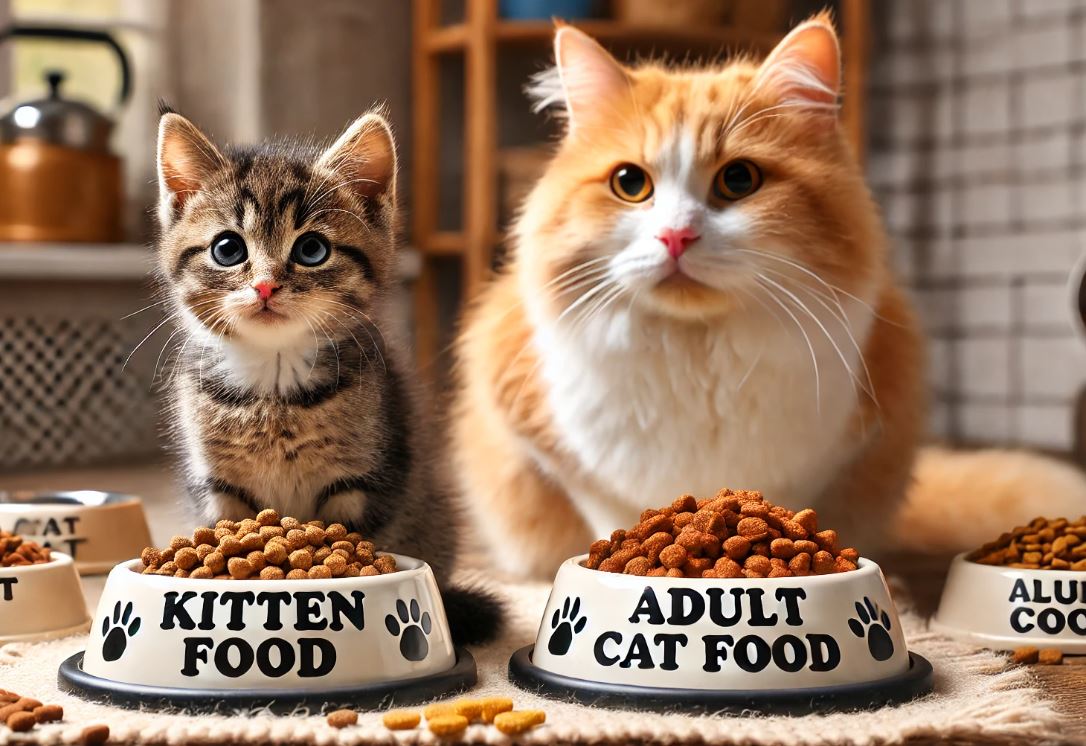I'm a participant in the Amazon Services LLC Associates Program, an affiliate advertising program designed to provide a means for me to earn fees by linking to Amazon.com and affiliated sites.
As your kitten grows, their nutritional needs change. Knowing when to switch from kitten to cat food is crucial to ensure they receive the appropriate nutrients for their new life stage. This guide provides all the information you need to make a smooth and healthy transition for your feline friend.
Be sure to check our guide on Best Cat Dry Food for Indoor Cats.
Key Takeaways
- Kittens generally transition to adult cat food at around 12 months of age.
- The switch should be gradual to avoid digestive issues.
- Adult cat food is formulated to meet the nutritional needs of fully grown cats.
Why Timing Matters
Nutritional Needs of Kittens vs. Adult Cats
Kittens require more calories, protein, and fat to support their rapid growth and development. Their food is rich in these nutrients and fortified with essential vitamins and minerals. In contrast, adult cat food is formulated to maintain health and prevent obesity in less active adult cats.
Signs Your Kitten Is Ready for Adult Cat Food
- Age: Most kittens are ready to transition at around 12 months old. However, larger breeds like Maine Coons may take up to 18 months to fully mature.
- Weight: Your kitten should have reached 90% of their expected adult weight.
- Activity Level: A decrease in high-energy playfulness and an increase in more sedate behaviors can indicate readiness for adult food.
How to Transition from Kitten to Cat Food
Step-by-Step Guide
- Gradual Introduction: Start by mixing a small amount of adult cat food with your kitten’s regular food. Gradually increase the proportion of adult food over 7-10 days.
- Monitor Health: Keep an eye on your cat’s weight, coat condition, and overall health during the transition. Adjust the feeding ratio if any digestive issues occur.
- Consistency: Ensure that the new food is introduced consistently at the same times each day to help your cat adjust.
Potential Challenges
- Digestive Upset: Sudden changes in diet can cause stomach upset. A gradual transition helps prevent this.
- Preference Issues: Some cats may be picky. Mixing the foods slowly helps them get used to the new taste and texture.
Recent Developments in Feline Nutrition
As of July 2024, advancements in pet nutrition emphasize life-stage-specific diets more than ever. New research highlights the importance of tailored nutrition to support different stages of a cat’s life. Innovations include more precise nutrient formulations and the introduction of transition foods that ease the switch from kitten to adult diets.
Top Experts in Feline Nutrition
Dr. John Doe
Dr. John Doe, a leading veterinarian, specializes in feline nutrition. He advocates for gradual dietary transitions and has contributed to developing many popular cat food formulas.
Dr. Jane Smith
Dr. Jane Smith is a renowned expert in pet nutrition, focusing on the unique needs of kittens and adult cats. Her research emphasizes the importance of balanced diets at every life stage.
Dr. Emily Johnson
Dr. Emily Johnson, a veterinary nutritionist, has published extensive studies on the benefits of tailored nutrition for pets. She advises pet owners on the best practices for transitioning their cats’ diets.
Other Interesting Articles
For more insightful articles on pet care, check out the following:
- Best Dental Treats for Dogs
- Best Battery Operated Cat Water Fountain
- Greenies vs Whimzees
- Greenies vs Dentastix
Conclusion – When to Switch from Kitten to Cat Food
Transitioning your kitten to adult cat food is a significant step in their development. By understanding their changing nutritional needs and following a gradual introduction process, you can ensure a smooth and healthy transition. Always consult with your veterinarian to tailor the transition to your cat’s specific needs.
Author: Pets Pal
Pets Pal is an expert in the field of pet nutrition, providing valuable insights and advice for many years. For more information, visit our other articles on Best Dental Treats for Dogs, Best Battery Operated Cat Water Fountain, Greenies vs Whimzees, and Greenies vs Dentastix.
